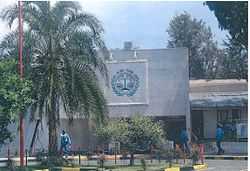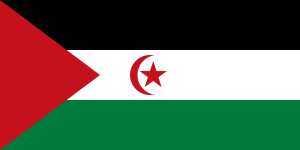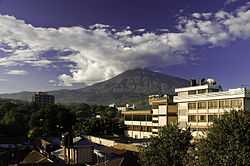Arusha
| City of Arusha | |
|---|---|
| City | |
|
Mt.Meru in the background of the City of Arusha | |
| Nickname(s): A-Town | |
 Location of Arusha City in Arusha Region | |
 City of Arusha Location of Arusha City in Arusha Region | |
| Coordinates: 3°22′S 36°41′E / 3.367°S 36.683°E | |
| Country |
|
| Region | Arusha Region |
| City | Arusha City Council |
| Incorporated Town | 1948 |
| Incorporated City | July 2010 |
| Government | |
| • Type | City Council |
| Elevation | 1,387 m (4,551 ft) |
| Population (2012)[1] | |
| • Total | 416,442 |
| Time zone | EAT (UTC+3) |
| • Summer (DST) | not observed (UTC+3) |
| Area code(s) | 027 |
| Climate | Cwb |
- This article refers to the City of Arusha. For other uses, see Arusha (disambiguation).
Arusha is a city in northern Tanzania and the capital of the Arusha Region, with a population of 416,442 plus 323,198 in the surrounding Arusha District (2012 census).[1] Located below Mount Meru on the eastern edge of the eastern branch of the Great Rift Valley, Arusha has a temperate climate. The city is close to the Serengeti National Park, the Ngorongoro Conservation Area, Lake Manyara National Park, Olduvai Gorge, Tarangire National Park, Mount Kilimanjaro, and Arusha National Park on Mount Meru.
Arusha is a major international diplomatic hub. The city hosts and is regarded as the de facto capital of the East African Community. Since 1994, the city has also hosted the International Criminal Tribunal for Rwanda. It is a multicultural city with a majority Tanzanian population of mixed backgrounds: indigenous Bantu, Arab-Tanzanian and Indian-Tanzanian population, plus small White European and white American minority population. Religions of the Arushan population are Christian, Jewish, Muslim, and Hindu.
History

The current site of Arusha was first settled in the 1830s by the agro-pastoral Arusha Maasai from the Arusha Chini community, south of Mount Kilimanjaro.[2]:page 112 They traded grains, honey, beer, and tobacco with the pastoral Kisongo Maasai in exchange for livestock, milk, meat, and skins.[2]:page 112 Demand for Arusha's foodstuffs increased substantially during the 1860s when the Pangani Valley trade route was extended through Old Moshi, Arusha, and ultimately to western Kenya.[2]:page 112 Although it was not yet a town, it was a regional centre and had a number of urban features.[2]:page 113
Arusha was conquered by the Germans in 1896 after the murder of the first two missionaries who attempted to settle on nearby Mount Meru.[2]:page 113 The Germans established a permanent presence in 1900 when a military fort (a boma) was built and soldiers were garrisoned there.[2]:page 113 "The boma was a solid statement, meant to impress German moral and political order on the surrounding countryside. Set on a rise overlooking the plains, the fortress-like building dominated the surrounding landscape" complete with a machine gun.[2]:page 113 Many Africans were forcibly displaced from their ancestral lands by the Germans and forced to dig lime or carry stones to construct the fort.[2]:page 114
The British took Arusha from the Germans in 1916 during World War I.[2]:page 114 German officials left the area, the British deported German missionaries and settlers, and only a skeletal military administration of the town remained.[2]:page 114 But slowly during the 1920s, civilian administration was implemented, missionaries from the United States arrived, British and Greek settlers reoccupied the former German farms, and the town grew, especially after the British moved the regional administration from New Moshi to Arusha.[2]:page 114 The extension of the railroad from Moshi to Arusha in 1928-29 greatly increased commerce.[2]:page 114 The Great Depression soon thereafter, however, squelched commerce, and Arusha in 1940 had less than 2,000 residents.[2]:page 115 Growth resumed during World War II and by 1948, the population had increased to more than 5,000.[2]:page 115
In the 1960s parts of the movie Hatari! with John Wayne were filmed at Momella.
Arusha has been a crucial city in the history of modern Tanzania. Official documents ceding independence to Tanganyika were signed by the United Kingdom at Arusha in 1961. Also, the Arusha Declaration was signed in 1967 in Arusha.
The Arusha Accords were signed at the city of Arusha on August 4, 1993, by representatives of competing factions in the Rwandan civil war.


In 1994 the UN Security Council decided by its Resolution 955 of 8 November 1994 that Arusha should host the International Criminal Tribunal for Rwanda. The establishment of the tribunal with its foreign employees has influenced the local economy of the city increasing the cost of living for residents. The tribunal is about to downsize due to its closure in 2014, but its legal successor, the International Residual Mechanism for Criminal Tribunals established by United Nations Security Council Resolution 1966, will continue entertaining a branch in Arusha, opening on 1 July 2012.
Arusha was officially declared a city on 1 July 2006 by the Tanzanian government.[3]
Industry and economy
The primary industry of the city is the service sector. The city hosts numerous small and large businesses, banking, retail and commercial enterprises thus making it the financial and cultural capital of the Arusha region. The city of Arusha is home the largest manufacturing sector in the region with breweries, tyre manufacturing and agro-forest processing, and a large pharmaceuticals maker.
Tourism is also a major contributor to the economy of the city of Arusha, being the second largest contributor of income in Tanzania. Given the city's location near some of the greatest national parks and game reserves in Africa including Serengeti National Park, Kilimanjaro National Park, Ngorongoro Conservation Area among others. Many documentary and feature-length films have been set in and around Arusha, including the 1962 Howard Hawks film Hatari! with John Wayne. Following this, some known actors and hunters, like Wayne, Hardy Krüger or Robert Taylor visited Arusha, staying in Hotels like the 1935-built Safari Hotel.[4]
The city of Arusha is the headquarters of the East African Community, and plays host to the International Criminal Tribunal for Rwanda and the African Court on Human and Peoples' Rights.
The city is home to the famous Arusha International Conference Center, host to many international meetings.
Arusha is also a well known destination for Non Governmental Organizations that operate out the city in a variety of regions and aid areas such as HIV and AIDS Awareness, children's education, and micro-finance.
Districts




Among Arusha's notable districts are the Central Business Area, located by the Clocktower, Sekei in the North-West which is largely residential with a vibrant nightlife, Njiro, a middle-class rapidly growing suburb in the South, and Tengeru, a lively market-town in the East.
North of Arusha are districts called Karatu, Ngorongoro, Monduli, Arumeru and Longido, about 90 minutes north of Arusha by daladala along the Arusha-Nairobi Road. Robanda Safari Camp is one of the favorite Safari Camps, located just outside Serengeti Ikoma Gate. This location was carefully chosen so as to be right in the path of the wildebeest migration. The best time to witness this spectacular migration is from May to August and from October to December. There is a high animal concentration year round though, with big herds of wildebeest and zebra, elephant and giraffe. Other animal species include lion, hyena, gazelle, topi, and buffalo.
Arusha's clock tower 03°22′20.5″S 036°41′40.1″E / 3.372361°S 36.694472°E is popularly supposed to be situated at the midpoint between Cairo and Cape Town, therefore representing the halfway point between the two termini of the old British Empire in Africa. However, the actual great circle midpoint between these two cities lies in central Congo. The clock tower is currently adorned by the logo of the Coca-Cola Company.
Transport
Arusha is mostly served by Kilimanjaro International Airport for international travellers, some 60 kilometres (37 mi) east, approximately halfway to Moshi. The airport provides international and domestic flights. Arusha Airport is in the west of the city and serves more than 87,000 passengers yearly. Travel by road can be done through privately run coaches (buses) to Nairobi, Dodoma and Dar Es Salaam, and other major cities in the nation.
Culture and cuisine
Arusha is known for its vibrant night life, with popular local night clubs like Club D, Masai Camp, Greek Club, Club AQ, the Colobus Club, and Via Via. [5]
The city Hosts The National Natural History Museum. The museum contains three exhibits on early man, plants and animals of the region, and the history of the city.[6]
There is a small museum adjacent to the Uhuru monument which displays information about the proceedings of the Arusha Declaration in 1967.
Arusha is also the headquarters of the African Great Lakes region's first local media center, Aang Serian Drum.
The city's cuisine is a blend of dishes from various parts of Tanzania as well as global culinary traditions. Nyama Choma, Kiti moto, Kuku choma is a very popular barbecue dish and is usually served with local cold beer and Pili Pili. Chips mayai is another popular local dish.
Education and health
Most Arushan children attend public schools located in almost every ward of the city. There are four international schools in and around Arusha: International School Moshi (Arusha Campus), Arusha International School, Braeburn School, and St Constantine's International School.

The city of Arusha is home to the National College of Tourism - Arusha Campus, Arusha Technical College, Tengeru Institute of community Development, The Nelson Mandela African Institute of Science and Technology, Eastern and Southern African Management Institute, MS Training Centre for Development Cooperation (MS-TCDC), The Institute of Accountancy Arusha, Forestry Training Institute, Olmotonyi, Tanzania Wildlife Research Institute, Makumira University College, The Arusha University and The Mount Meru University. Whereas plan for Aga Khan University-Arusha Campus is in the initial stages.
Arusha is home to the largest medical hospitals in Arusha Region. Mount Meru Hospital and Arusha Lutheran Medical Center are among the largest in the city.
Geography and climate
Despite its proximity to the equator, Arusha's elevation of 1,400 metres (4,600 ft) on the southern slopes of Mount Meru keeps temperatures relatively low and alleviates humidity. Cool dry air is prevalent for much of the year. The temperature ranges between 13 and 30 degrees Celsius with an average around 25 degrees. It has distinct wet and dry seasons, and experiences an eastern prevailing wind from the Indian Ocean, a couple of hundred miles east.
| Climate data for Arusha | |||||||||||||
|---|---|---|---|---|---|---|---|---|---|---|---|---|---|
| Month | Jan | Feb | Mar | Apr | May | Jun | Jul | Aug | Sep | Oct | Nov | Dec | Year |
| Average high °C (°F) | 29 (84) |
29 (84) |
27 (81) |
25 (77) |
22 (72) |
21 (70) |
21 (69) |
22 (72) |
24 (76) |
27 (80) |
27 (81) |
27 (81) |
25.1 (77.3) |
| Average low °C (°F) | 10 (50) |
11 (51) |
12 (53) |
14 (57) |
11 (52) |
9 (48) |
9 (49) |
9 (48) |
8 (47) |
11 (51) |
11 (51) |
10 (50) |
10.4 (50.6) |
| Average precipitation mm (inches) | 58 (2.3) |
84 (3.3) |
180 (7) |
368 (14.5) |
211 (8.3) |
33 (1.3) |
15 (0.6) |
20 (0.8) |
20 (0.8) |
36 (1.4) |
112 (4.4) |
100 (4) |
1,237 (48.7) |
| Source: Weatherbase[7] | |||||||||||||
Sports
The city is home to Tanzanian rugby national team.The city hosts International rugby matches as well. Joshua Peterson who played for the national team was the second youngest international rugby player ever behind Johnny Wilkinson. Southern Pool A of the 2007 Castel Beer Trophy was hosted here as well.
The city is home to Arusha FC, playing in Sheikh Amri Abeid Memorial Stadium, represents the city in Tanzanian league football.
The city also hosted The Mount Meru Marathon was held from 1985 to 2004.[8] The "all-comers" record for the fastest marathon performance in Tanzania, 2:13:46, was set at the event by former long-distance runner Benedict Ako on August 1, 1993.[9]
On May 21, 2011, the Drake University Bulldogs beat the CONADEIP All-Stars 17-7 in the first ever American Football Game in Tanzania.
In popular culture
Arusha was the setting for the 1962 film Hatari! directed by Howard Hawks and starring John Wayne. In the video game Halo 3, a highway sign is seen that says "Arusha", though it is crossed out, suggesting that the city was destroyed by the Covenant.
Sister cities
-
 Durham, North Carolina, USA
Durham, North Carolina, USA -
 Kansas City, Missouri, USA
Kansas City, Missouri, USA -
 Mürzzuschlag, Austria
Mürzzuschlag, Austria -
 Tifariti, Western Sahara
Tifariti, Western Sahara
See also
- Arusha Accords
- Arusha Cultural Heritage Centre
- Arusha Declaration
- Arusha National Park
- Arusha Region
- Lake Manyara
- Longido
- Mount Meru (Tanzania)
- Selian
- Tanzania
- United Nations Security Council resolution
References
- ↑ 1.0 1.1 Population Distribution by Administrative Areas, 2012 Population and Housing Census, National Bureau of Statistics, United Republic of Tanzania, 2013, page 26, accessed 1 November 2014
- ↑ 2.0 2.1 2.2 2.3 2.4 2.5 2.6 2.7 2.8 2.9 2.10 2.11 2.12 2.13 "'A Town of Strangers' or a 'Model Modern East African Town'? Arusha & the Arusha", authored by Thomas Spear, in Africa's Urban Past, edited by David Anderson and Richard Rathbone, James Currey Publishers, 2000, accessed 31 October 2014
- ↑ Arusha Times
- ↑ The New Safari Hotel at Arusha Hotels and Lodges. Africanlegendsdmc.com Retrieved 25.June 2013
- ↑ http://www.lonelyplanet.com/tanzania/northern-tanzania/arusha/entertainment-nightlife
- ↑ http://aroundarusha.com/content/natural-history-museum
- ↑ "Weatherbase: Historical Weather for Arusha, Tanzania". Weatherbase. 2011. Retrieved on November 24, 2011
- ↑ "Mount Meru Marathon". Association of Road Racing Statisticians. Archived from the original on 20 October 2010. Retrieved October 30, 2010.
- ↑ "All-Comers Records- Marathon". Association of Road Racing Statisticians. Archived from the original on 20 October 2010. Retrieved October 30, 2010.
External links
| Wikimedia Commons has media related to Arusha. |
| Wikiquote has quotations related to: Arusha |
- Forestry Training Institute Olmotonyi (FTI)
- Eastern and Southern Africa Management Institute
- David Marsh's Childhood Map of European Area of Arusha, ca. 1956
| ||||||

